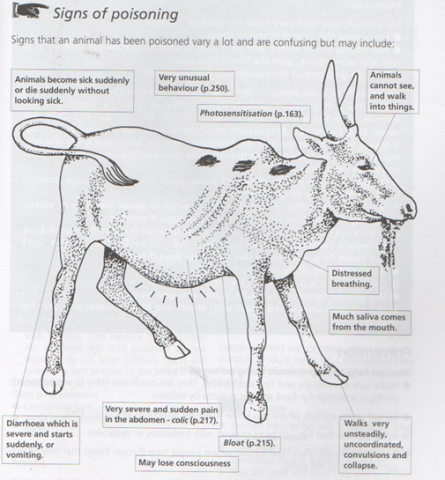Introduction
Compared with some parts of the world East Africa is fortunate in the relatively small losses of stock which occur from poisonous plants. Although there are a great number of plants which have been shown to be toxic by drenching experiments only a few are known to have been responsible for actual deaths under natural conditions. Many illnesses which at one time were attributed to plant poisoning are now recognised as being due to infectious diseases and not to poisoning at all.
Except in the case of individual, newly introduced animals, isolated cases of plant poisoning are rare. Plant poisoning usually occurs as an outbreak and as a result when it does occur, losses may be heavy.
Animals which have been bred in a particular district usually know which plants are edible and which are not. Poisoning in such animals may, however, occur when grazing is scarce, or when they are taken to a new area of grazing on the same farm. Animals newly introduced to a district will frequently eat toxic species with which they are unfamiliar.
Another cause of stock poisoning is the contamination of prepared fodder or concentrates with poisonous material which the animal might well recognise and avoid in its natural state. In addition certain foodstuffs which are harmless if fed in reasonable amounts, are toxic if fed as the main article of diet. Aflatoxin containing feedstuffs are also a risk.

(c) Forse 1999
Prevention of plant poisoning
You can help to stop animals getting poisoned by:
- Making sure animals are well fed and healthy. Healthy well fed animals are much less likely to eat poisonous plants or scavenge for food and eat poisons by mistake.
- Do not graze animals where you know there are poisonous plants
- Avoid pastures that have just been fertilised with nitrogen in any form or sprayed with herbicides or pesticides
- Do not let animals graze near rubbish where people have thrown things that may be poisonous like old paint.
Review Process
- Draft By William Ayako, Aug - Dec 2009
- Review by Hugh Cran March 2010 - Jan 2011
- Review workshop team. Nov 2 - 5, 2010
- Anne Bruntse, Jan 2013
- For Infonet: Anne, Dr Hugh Cran
- For KARI: Dr Mario Younan KARI/KASAL, William Ayako - Animal scientist, KARI Naivasha
- For DVS: Dr Josphat Muema - Dvo Isiolo, Dr Charity Nguyo - Kabete Extension Division, Mr Patrick Muthui - Senior Livestock Health Assistant Isiolo, Ms Emmah Njeri Njoroge - Senior Livestock Health Assistant Machakos
- Pastoralists: Dr Ezra Saitoti Kotonto - Private practitioner, Abdi Gollo H.O.D. Segera Ranch
- Farmers: Benson Chege Kuria and Francis Maina Gilgil and John Mutisya Machakos
- Language and format: Carol Gachiengo
Information Source Links
- Blundell, Michael 1987: Collins Guide to Wild Flowers of East Africa.William Collins Sons & Co. Ltd.
- Common Poisonous Plants of East Africa Verdcourt & Trump Collins St Jame's Place London 1969
- The Merck Veterinary Manual 9th Edition 2005 ISBN 0-911910-50-6
- Clarke: Poisoning in Veterinary Practice The Association of the British Pharmaceutical Industry 162 Regent Street London W1R 6DD 1975
- Forse, Bill 1999: Where There Is No Vet. Macmillan publishers Limited. ISBN 978 0 333 58899 4 ISBN: 0 85598 409 0
- Radostits and Henderson: Veterinary Medicine A Textbook of the Diseases of Cattle, Sheep, Pigs, Goats and Horses Blood, 6th Edition ISBN 0-7020-0988-1
- World Agroforestry Centre 2007: Useful Trees and shrubs for Ethiopia. RELMA Publication, ICRAF. ISBN 92 9059 212 5
